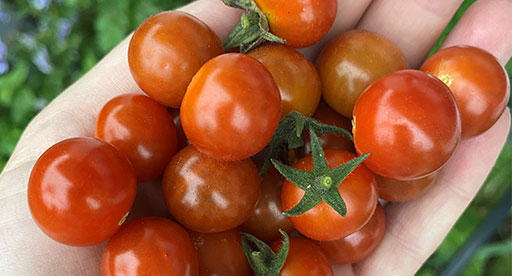
Tomatoes take pride of place in many Kiwi gardens over the summer - you just can't beat the taste of homegrown!
Sometimes Mother Nature has other plans and rain, extreme heat and humidity can affect the health of your plants.
We often get asked for advice on tomatoes so we've put together the most common tomato problems and solutions.
The key to successful tomato growing
To help prevent and overcome common problems keep plants actively growing:
- Plant in full sun, in a free draining soil enriched with Tui Tomato Mix.
- Keep tomatoes well watered.
- Regularly feed every 4-6 weeks.
- Apply Tui Seaweed Plant Tonic every 7-14 days to help build resilience.
- Remove the bottom leaves up to the first truss of tomatoes as the leaves start to yellow and turn brown.
Garlic, basil, chives, onions, parsley, marigold, nasturtium and carrots are perfect companions for tomatoes.
Common tomato problems
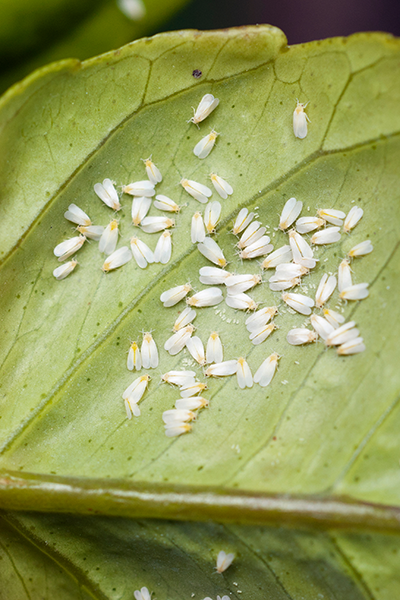
Whitefly
Insects
Whitefly are small sap sucking white flies that live on the underside of the leaf that fly away in a cloud when the plant is disturbed, causes yellowing of leaves and reduced vigour.
- Treatment: Spray with a suitable low toxicity insecticide or natural control, re-spray every 7-10 days to break the lifecycle.
Aphids are small sap sucking insects that cause the leaves to distort and on untreated plants leaves turn yellow, reducing plant vigour. Aphids can be green, black or brown.
- Treatment: use a low toxicity insecticide ensuring the underside of the leaves are sprayed.
Fruit worm are small caterpillars that tunnel into unripe green fruit.
- Treatment: look for leaves that have been eaten by caterpillars or caterpillar droppings around the plant. Squashing the caterpillars is the most effective control. Remove fruit that has holes in them and dispose of in the rubbish.
Psyllid are sap sucking insects similar in size to aphids that are prevalent in September-November, with a lifecycle that continues throughout the year. When psyllid feed on plants they inject a bacteria that translocates down to the roots, infecting the whole plant, causing leaves to yellow, distort, and curl, flower drop, and small misshapen fruit.
- Treatment: there are very limited sprays available to the home gardener to control psyllid - talk to your local garden centre for spray advice. Cover plants in a fine insect mesh to prevent the insect getting to the plant. Remove all infected plant material from the garden. Infected plants need to be disposed of - do not add to the compost.
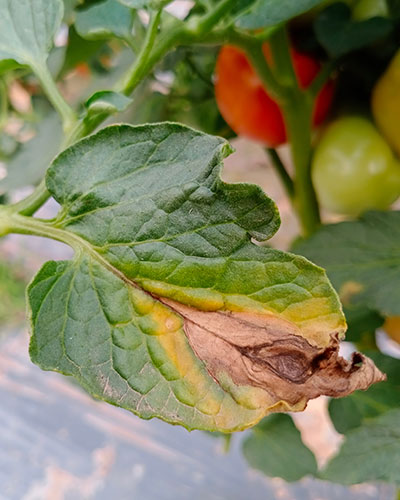
Early blight
Disease blights
Early Blight: the first signs of early blight are leaf spots with yellowing lower leaves. The foliage turns brown, shrivels and dies. If bought under control Early Blight doesn't usually affect flowering and fruiting later in the season. Early Blight occurs during warm, humid wet weather in early spring and can also affect stressed plants.
Late Blight: leaves develop irregular greenish-brown mushy spots in the edge of the leaf. Dark patches appear on the stem of the plant, the spots grow quickly and often there is a greyish mould on the underside of the leaves or on the stem. The leaves shrivel up and die. Late Blight also causes fruit to rot if the disease is not treated. Prevalent in warm humid wet weather especially in late summer.
Treatment:
- Remove infected leaves as soon as they appear. Remove the lower leaves up to the first truss of fruit to help improve air circulation around the plants. Water the soil, avoid overhead watering or excessively wetting the leaves.
- Stake plants to help improve air circulation. Remove infected plant material and dispose of - do not compost as the spores can overwinter in the soil.
- Clean cutting tools as it can be spread by cutting tools and avoid planting in the same spot each year. Mulch around plants to help conserve soil moisture and keep plants protected during wet warm humid weather using a copper based fungicide.
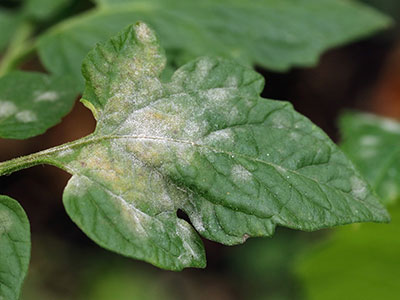
Powdery mildew
Powdery mildew
Very common in summer and autumn in warm humid weather. Plants have the appearance of having been dusted with flour. It usually appears first on the top side of the leaves, moving to the underside and the stem.
Treatment:
- Avoid overhead watering and improve air circulation around the plant by staking and removing the lower leaves. Ensure good ventilation if growing tomatoes in a glasshouse. Keep plants protected during warm humid weather using a copper based fungicide. Remove infected plant material and dispose of but don’t compost.
- Some gardeners find weekly or fortnightly applications of Apple Cider Vinegar is a good way to keep fungal diseases at bay. Mix 1 cup of Apple Cider Vinegar in 5 litres of water in a sprayer and apply to the whole garden.
Other issues caused by weather, watering or feeding
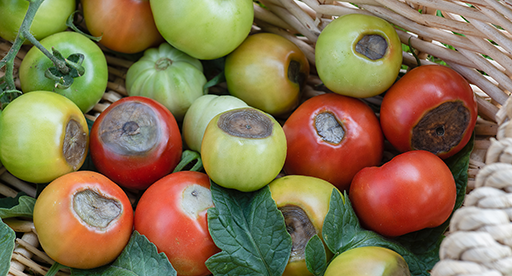
Blossom end rot
Blossom end rot
The bottom of fruit forms a brown shrivelled sunken patch. Not all fruit are affected, there will be healthy fruit on the truss as well. It particularly affects tomatoes grown in pots and containers. Blossom end rot is a deficiency usually caused by a lack of calcium and magnesium, but can also be caused by inconsistent watering - the plant is unable to take up enough nutrients from the soil due to insufficient water.
- Treatment: pick off affected fruit and ensure plants are consistently watered throughout the season. Apply mulch around the plant to help conserve soil moisture and prevent plants drying out. Tomatoes are gross feeders and require regular feeding every 4-6 weeks. Smaller tomato varieties such as Sweet 100 are not affected as much by Blossom End Rot.
Green tops of fruit
The bottom of the fruit ripens but the tops stay green is caused by excessive sunlight, insufficient watering, too much potassium (potash).
- Treatment: apply a balanced fertiliser and water plants consistently. Provide protection using shade cloth. Apply Tui Seaweed Plant Tonic.
Blotchy fruit
Fruit is blotchy and doesn’t fully ripen. This is caused by to much heat, soil nutrient imbalance with a lack of potassium (potash) and over watering.
- Treatment: feed with a balanced fertiliser rich in potassium, reduce watering, water consistently depending upon the weather, apply Tui Seaweed Plant Tonic.
Fruit splitting
Splits appear in the fruit when the flesh grows faster than the skin. This is caused by inconsistent watering and is often during wet weather. If left on the plant the fruit will rot.
- Treatment: ensure plants are consistently watered. If caused by excessive rain remove the fruit as soon as it splits, eat straight away or use for relish. Grow varieties that are resistant to splitting. If wet weather is expected remove fruit showing signs of ripening and ripen off the vine.
Distorted curled leaves
Usually caused by excessive heat or temperature fluctuations from hot to cold.
- Treatment: Mulch around the plant to help maintain constant soil moisture and protect the roots from temperature extremes. Apply Tui Seaweed Plant Tonic regularly in the growing season. Plants usually grow out of it. Note, tomatoes are sensitive to spray drift from herbicides. Make sure any spraying is done on a still day and well away from tomatoes.
Post a comment
Top tomato problems Comments
Be the first to write a comment